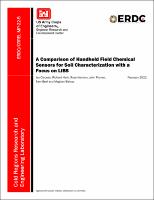Please use this identifier to cite or link to this item:
https://hdl.handle.net/11681/43282| Title: | A comparison of handheld field chemical sensors for soil characterization with a focus on LIBS |
| Authors: | Clausen, Jay L. Harmon, R. S. (Russell S.) Beal, Samuel A. Bishop, Meghan Hark, Richard Plumer, John R. |
| Keywords: | Scientific apparatus and instruments Chemistry, Analytic Soils--Testing Raman spectroscopy X-ray spectroscopy Laser-induced breakdown spectroscopy |
| Publisher: | Engineer Research and Development Center (U.S.) |
| Series/Report no.: | Miscellaneous Paper (Engineer Research and Development Center (U.S.)) ; no. ERDC/CRREL MP-22-5 |
| Abstract: | Commercially available handheld chemical analyzers for forensic applications have been available for over a decade. Portable systems from multiple vendors can perform X-ray fluorescence (XRF) spectroscopy, Raman spectroscopy, Fourier transform infrared(FTIR) spectroscopy, and recently laser-induced breakdown spectroscopy (LIBS). Together, we have been exploring the development and potential applications of a multisensor system consisting of XRF, Raman, and LIBS for environmental characterization with a focus on soils from military ranges. Handheld sensors offer the potential to substantially increase sample throughput through the elimination of transport of samples back to the laboratory and labor-intensive sample preparation procedures. Further, these technologies have the capability for extremely rapid analysis, on the order of tens of seconds or less. We have compared and evaluated results from the analysis of several hundred soil samples using conventional laboratory bench top inductively coupled plasma atomic emission spectroscopy (ICP-AES) for metals evaluation and high-performance liquid chromatography (HPLC) and Raman spectroscopy for detection and characterization of energetic materials against handheld XRF, LIBS, and Raman analyzers. The soil samples contained antimony, copper, lead, tungsten, and zinc as well as energetic compounds such as 2,4,6-trinitrotoluene(TNT), hexahydro-1,3,5-triazine (RDX), nitroglycerine (NG), and dinitrotoluene isomers (DNT). Precision, accuracy, and sensitivity of the handheld field sensor technologies were compared against conventional laboratory instrumentation to determine their suitability for field characterization leading to decisional outcomes. |
| Description: | Miscellaneous Paper |
| Gov't Doc #: | ERDC/CRREL MP-22-5 |
| Rights: | Approved for Public Release; Distribution is Unlimited |
| URI: | https://hdl.handle.net/11681/43282 http://dx.doi.org/10.21079/11681/43282 |
| Appears in Collections: | Miscellaneous Paper |
Files in This Item:
| File | Description | Size | Format | |
|---|---|---|---|---|
| ERDC-CRREL MP-22-5.pdf | 2.99 MB | Adobe PDF |  View/Open |